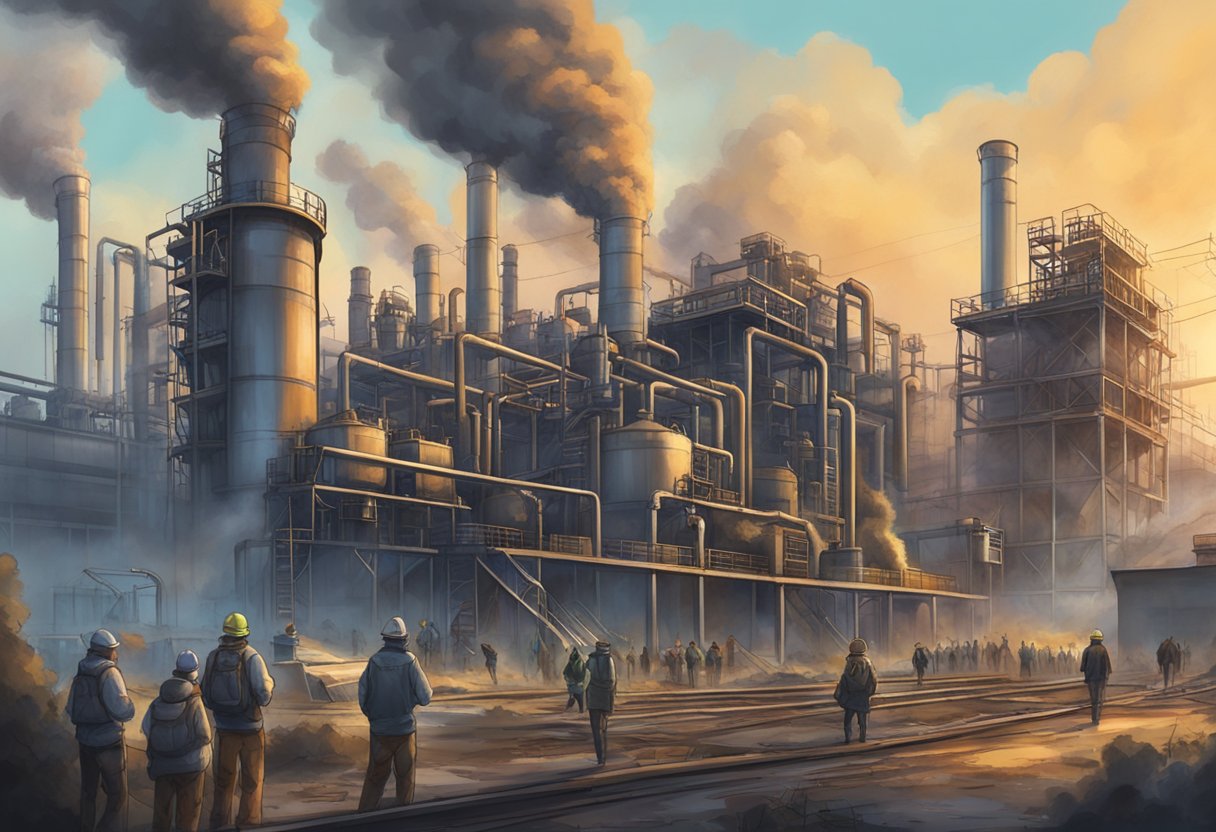The Bhopal Industrial Disaster: Corporate Negligence and Its Consequences Explained

The Bhopal Industrial Disaster remains one of the most severe instances of corporate negligence in history. On the night of December 3, 1984, the Union Carbide pesticide plant in Bhopal, India, leaked over 40 tons of methyl isocyanate gas. This disaster caused immediate deaths and long-term health problems for thousands of people.
This catastrophic event highlighted critical failures in safety standards and regulatory oversight. The immediate aftermath saw around 3,800 people losing their lives, with many more suffering from chronic illnesses. Legal battles ensued, centering around issues of corporate responsibility and compensation for the victims.
The tragedy's impact extends beyond health. It prompted legislative changes and increased scrutiny on corporate practices globally. Understanding the intricate details of the Bhopal Gas Tragedy sheds light on the urgent need for stringent safety regulations and accountability in industrial operations.
Overview of the Bhopal Disaster
The Bhopal Disaster was one of the deadliest industrial accidents in history, resulting from a toxic gas leak at a pesticide plant. This section will discuss the events leading up to the disaster and the chemical involved.
Chronology of Events
On December 3, 1984, at a Union Carbide pesticide plant in Bhopal, India, a tragic incident occurred when more than 40 tons of toxic gas leaked. The gas, primarily methyl isocyanate (MIC), spread rapidly over the surrounding area, affecting thousands.
The leak began shortly after midnight, and within hours, the city was engulfed. The initial release killed at least 3,800 people immediately. Many more suffered from severe health issues, and the death toll continued to rise in the following weeks and months. Emergency response was slow and inefficient, exacerbating the tragedy.
Ongoing legal battles and efforts to secure compensation for the victims of the Bhopal Gas Tragedy have lasted for decades. The event highlighted severe shortcomings in industrial safety standards and corporate accountability.
Chemical Involved: Methyl Isocyanate
Methyl isocyanate (MIC) is a highly toxic and volatile chemical used in pesticide production. At the Union Carbide plant, MIC was stored in large tanks. On December 3, a series of safety failures allowed water to enter one of these tanks, triggering a chemical reaction.
The reaction caused a rapid increase in temperature and pressure, leading to the release of MIC gas. Exposure to MIC can cause severe respiratory problems, eye irritation, and even death. The gas is particularly dangerous because it is heavier than air, allowing it to settle and persist in low-lying areas.
Despite warnings and previous accidents, safety standards at the plant were found to be woefully inadequate, culminating in the catastrophic leak.
Health Impacts and Environmental Damage

The Bhopal disaster caused severe health issues for those exposed to the toxic gas and led to significant environmental damage. Below, the immediate health effects, long-term public health issues, and ongoing environmental contamination are explored in detail.
Immediate Health Effects
On the night of December 3, 1984, a massive leak of methyl isocyanate gas from a pesticide plant in Bhopal, India, led to immediate and devastating health effects for the local population. The gas caused pulmonary edema, where the lungs fill with fluid, leading to severe breathing difficulties and a high death toll.
Many exposed individuals suffered from coughing, eye irritation, and throat burning. Within hours, thousands of people died from exposure, making it one of the deadliest industrial accidents in history. Emergency services were overwhelmed, and hospitals struggled to treat the massive influx of patients.
Long-Term Public Health Issues
Even decades after the disaster, the public health impact continues to be profound. Many survivors suffer from long-term respiratory issues, including chronic obstructive pulmonary disease (COPD) and asthma. Children born to exposed parents also face higher rates of congenital disabilities and developmental problems.
Psychological effects have also been significant. Many residents live with ongoing trauma and mental health issues due to the disaster. Studies indicate a higher prevalence of mental disorders among survivors, adding another layer to the public health challenge.
Environmental Contamination
The disaster led to extensive contamination of the local environment. High levels of toxic chemicals were found in the soil and water around the plant, making the area uninhabitable and causing further health risks. Many chemicals, including the notorious methyl isocyanate, persisted in the environment years after the incident.
Efforts to clean up the contamination have been slow. The Environmental Protection Act has mandated actions to address the contamination but progress remains insufficient. Many locals still rely on polluted water sources, raising concerns over ongoing exposure to harmful chemicals.
Efforts to address the environmental and health impacts remain an ongoing struggle. The disaster's legacy shows the need for strict safety measures and corporate accountability to prevent future tragedies.
Union Carbide Corporation's Role

The Union Carbide Corporation (UCC) played a pivotal role in the Bhopal disaster through inadequate safety measures and corporate negligence.
Corporate Responsibilities and Failures
Union Carbide Corporation owned a significant stake in Union Carbide India Limited (UCIL), the operator of the Bhopal plant. Corporate responsibility demanded strict oversight and maintenance protocols.
Despite knowing the risks associated with Methyl Isocyanate (MIC), the company failed to ensure proper safety standards. Inadequate training for employees and lack of emergency response plans contributed to their failure. Poor decisions made by the company's management and its negligence resulted in catastrophic consequences.
Union Carbide Corporation also failed to adhere to regulatory guidelines. Their negligence extended to cost-cutting measures that compromised the plant's integrity, such as reducing the workforce and not repairing or replacing critical equipment.
Safety Measures and Neglect
The safety measures at the Bhopal plant were grossly insufficient. Multiple safety systems were either turned off or malfunctioning on the night of the gas leak. Key safety devices, like the vent gas scrubber and flare tower, were non-operational.
There was inadequate maintenance of essential safety equipment. Routine checks and necessary repairs were often ignored. Poor monitoring of the plant's condition led to an undetected water leak into the MIC tank, triggering the lethal gas release.
The lack of proper safety measures and lack of preparedness worsened the impact. Despite alarms, the response was slow and lacked coordination, showcasing a severe breach in safety protocols.
Legal and Political Repercussions

The Bhopal industrial disaster led to significant legal battles and political actions. Efforts to secure compensation for victims were substantial, and the incident prompted governments to reevaluate industrial safety laws.
The Legal Battle for Compensation
The legal fight for compensation after the Bhopal disaster was long and complicated. Victims sought justice from Union Carbide, the company operating the plant where the gas leak occurred. In 1989, a settlement was reached with Union Carbide agreeing to pay $470 million.
Despite the settlement, many victims felt the compensation was inadequate given the scale of the tragedy. Legal proceedings continued for years, with unresolved issues about the adequacy of the compensation and the distribution of funds. Litigation faced several hurdles, including jurisdictional disputes and procedural delays.
The Role of Governments
Both the Indian government and international entities played crucial roles in addressing the aftermath of the disaster. The Indian government passed the Bhopal Gas Leak Disaster Act in 1985, giving itself exclusive rights to represent all victims in legal actions against Union Carbide.
Political decisions significantly influenced the legal process. For example, the Indian government’s decision to settle for $470 million was controversial. The government was criticized for accepting a deal that many saw as insufficient. International pressure and lobbying also shaped the legal landscape, urging stricter industrial regulations.
Legislation and Changes in Law
The Bhopal disaster prompted significant changes in laws regarding industrial safety and corporate liability. In India, new regulations were introduced to improve safety standards and ensure better risk management in industrial operations.
Key legislative changes included stricter environmental laws and enforcement mechanisms. The Bhopal Gas Leak Disaster Act was one of the early legislative responses, aiming to streamline the legal process for compensation. Additionally, global standards and practices regarding industrial safety and corporate accountability saw an overhaul, influenced by the Bhopal tragedy.
These changes aimed to prevent similar incidents and hold corporations accountable for negligence. New policies and regulations were implemented to strengthen oversight and ensure better safety compliance in industrial operations across the world.
Case Studies and Lessons Learned

Analyzing the Bhopal disaster provides key insights into the areas of industrial safety and corporate accountability. Focusing on lessons can prevent future incidents and improve safety standards.
Analyses of Industrial Safety
Industrial disasters like Bhopal highlight the importance of Process Safety Management (PSM). At Bhopal, the failure of safety systems such as multiple alarms, proper maintenance, and effective employee training led to catastrophic results.
A study into Bhopal's Corrosion Risk Management revealed severe lapses in handling chemicals. Equipment being poorly maintained and safety protocols not adhered to meant that hazards were not properly controlled.
Case studies often show that regular maintenance and rigorous safety checks are crucial. Companies must take proactive measures to test and replace outdated equipment to avoid similar occurrences.
Improving Corporate Accountability
Corporate accountability was severely lacking during the Bhopal disaster. Union Carbide's reluctance to accept responsibility and delay in providing adequate compensation showed major corporate negligence.
Lessons from Bhopal stress the need for companies to have clear accountability structures. Corporations must ensure that policies are in place for accountability in case of accidents, including adequate compensation and support for the affected communities.
Enforcing ethical business practices and transparency can also prevent future mishaps. Businesses should adopt comprehensive safety and responsibility frameworks to handle crisis situations effectively.
These steps can help companies build a safer industrial environment, ensuring that the tragedies like Bhopal do not repeat.
Social and Economic Impact on Bhopal
The Bhopal disaster had profound social and economic repercussions for the city. Families were torn apart, livelihoods were lost, and local businesses struggled to survive.
Community and Lifestyle Disruptions
Bhopal faced immense social upheaval following the disaster. Over 3,800 people died immediately, causing widespread grief and trauma. The surviving community dealt with ongoing health issues, including respiratory problems and vision impairment.
Families were often left without primary breadwinners, forcing many into poverty. Children lost their parents, and traditional family structures broke down. Public trust eroded, especially toward large corporations and authorities. This mistrust affected how people interacted with businesses and government in the aftermath.
Many residents had to leave their homes as entire neighborhoods were contaminated. Those who stayed faced deteriorating living conditions. Basic services like healthcare and education were strained, making daily life very challenging for the survivors.
Economic Challenges Post-Disaster
The economic impact of the disaster was severe. Local businesses in Bhopal suffered as the population struggled with health issues and economic instability. Many shops and small enterprises faced closure due to a lack of customers and staff who were either dead or incapacitated.
Bhopal, like many developing countries, faced significant economic pressure in trying to rebuild. The disaster led to massive cleanup costs, and the city’s infrastructure needed urgent attention. Resources that could have gone to development were diverted to relief and rehabilitation.
Job opportunities dwindled, and unemployment rates soared. Those who could work found it difficult to secure stable jobs, further straining the economy. Relief and rehabilitation efforts, though substantial, often fell short of addressing the long-term economic needs of the people.
Impact on Global Industrial Practices
The Bhopal disaster significantly changed how transnational corporations operate and how they manage industrial pollution. It emphasized the need for stringent safety regulations and corporate accountability.
Shifts in Transnational Corporate Policies
After the Bhopal disaster, many transnational corporations reevaluated their safety protocols. They began to implement more rigorous risk management strategies and invested in advanced safety technologies. Companies realized the severe consequences of neglecting safety, including financial losses, legal battles, and damage to their reputations.
Several corporations established independent safety audits and emergency response plans to respond swiftly to any industrial accidents. The disaster also pushed for greater transparency, with companies being more open about their safety measures and potential risks. This shift aimed to regain public trust and prevent another tragedy like Bhopal.
Global Response to Industrial Pollution
The Bhopal incident raised global awareness about industrial pollution and its devastating effects. Governments worldwide began to tighten environmental regulations to hold corporations accountable for their emissions and waste. International agreements, such as the Basel Convention, were strengthened to control the movement of hazardous wastes.
Further, the disaster prompted a more integrated global approach with nations cooperating to develop uniform safety standards. Environmental watchdogs and NGOs became more active, monitoring corporate activities and advocating for stricter laws. These efforts led to the establishment of various green initiatives and sustainable practices to minimize industrial pollution and protect public health.




